42mm screw lenses

|
| M42 lenses image by Brian Eager (Image rights) |
This page is about the 42×1.0mm thread M42 screw mount used to attach lenses to SLR cameras, most popular in the 1960s.
This page is NOT about the T mount thread measuring 42×0.75mm which screws into adapters ("T-rings") which fit many other types of SLR lens mount, first developed by Tamron.
The 42mm screw mount was introduced in 1949 with the Contax S 35mm SLR made by the East German firm VEB Zeiss Ikon. It was also adopted by the East German firm KW on their Praktica range of cameras, introduced around the same time as the Contax S. In the early 1950s the mount was also used by the West German firm Wirgin on their Edixa Reflex range of cameras. Later (1957) it was adopted by Asahi for the Asahi Pentax family of SLRs which sparked the Japanese camera industry. In the 1960s several other Japanese manufacturers also adopted the mount for their new 35mm system cameras. It was also used by the Russians on Zenits from the second production run of the Zenit E onwards.
In 1956 the Contax F introduced an internal aperture stop-down pin located at 6 o'clock inside the lens mount. Versions of this innovation were adopted by practically all subsequent users of the M42 mount (with the exception of preset or T mount lenses), though early adaptations varied slightly by manufacturer. By the early 1960s the diaphragm actuation mechanism had been standardized as many more companies began using the mount for their system 35mm cameras. Praktica was once again an early adopter.
In 1959 both VEB Zeiss Ikon and KW were absorbed into the new East German Pentacon camera manufacturing consortium. All subsequent Pentacon 35mm SLR cameras (most of which were continuations of VEB Zeiss Ikon or KW lines) of the 1960s used the M42 mount.
Despite the standardization of the diaphragm actuation mechanism, there was no industry standard for communicating the aperture ring position to a TTL light meter. Before screw-mount lenses faded from the scene, Mamiya, Pentax, Fuji, Olympus, Zeiss Ikon and Pentacon all introduced mutually incompatible systems to permit open-aperture metering; but the majority of TTL metered M42 cameras simply use stop-down metering instead.
In the 1970s, as camera electronics and in-camera metering systems rapidly became much more sophisticated, requiring very accurate mounting tolerances to establish electrical contacts between a camera body and lenses, the technical limitations of a screw-mount lens system quickly rendered the M42 mount obsolete. The M42 mount was progressively replaced by bayonet mounts by all the manufacturers that used it, except on some Zenits. Recently Cosina Voigtländer reintroduced a 42mm screw mount SLR with the Bessaflex TM (2004).
This mount is also called Universal screw mount, Pentax screw mount, Praktica screw mount, or M42 for short. The mount is also sometimes referred to as the P-Mount, which homogenizes the various Pentax, Praktica, or Pentacon associations with the mount.
Due to its relatively long flange focal distance (45.46mm) glassless adapters have been marketed that will allow M42 lenses to be used on bodies with the Pentax K-mount, the Canon FD or EF mount, the Nikon F mount, the Minolta MD or α mount, the Olympus OM mount, the Konica AR mount, and other 35mm SLR mounts. Some manufacturers wanted to maintain continuity and offered user-friendly adapters with the ability to push the aperture pin automatically for stopping-down. Those adapters were made for cameras with Fuji X-mount, for some cameras with Rollei QBM-mount (e.g. Rolleiflex SL35), and for the Mamiya NC1000(s). Adapters are also available to use M42-mount lenses on virtually all digital mirrorless interchangeable lens cameras as well.
There have been a huge number of lenses produced in M42 mount, made by all sorts of manufacturers; a sample are listed below.
Contents
- 1 Arco
- 2 Asahi Optical / Pentax
- 3 Beroflex
- 4 Berogon
- 5 Berthiot
- 6 Beauty
- 7 Cimko
- 8 Corfield
- 9 Enna
- 10 FED
- 11 Feinmess
- 12 Fuji
- 13 Fujita
- 14 Hanimar
- 15 Hoya
- 16 Ichizuka
- 17 Isco
- 18 JML
- 19 Kilfitt
- 20 KMZ
- 21 Sankyō Kōki / Komura
- 22 Kowa
- 23 Kyoei (Acall)
- 24 E.Ludwig
- 25 Mamiya-Sekor
- 26 Meyer
- 27 Miranda
- 28 Nittō Kōgaku
- 29 Olympus
- 30 Pentacon
- 31 Petri (Kuribayashi)
- 32 Piesker
- 33 Porst
- 34 Rau Optik
- 35 Revuenon
- 36 Ricoh
- 37 Robotar
- 38 Rodenstock
- 39 Roeschlein
- 40 Rollei
- 41 Schacht
- 42 Schneider
- 43 Siclass
- 44 Sigma
- 45 Soligor
- 46 Steinheil
- 47 Sun
- 48 Tamron
- 49 Tokina
- 50 Tomioka
- 51 Vivitar
- 52 Weltblick
- 53 Yashica
- 54 Zeika
- 55 Zeiss
- 56 Notes
- 57 Links and sources
Arco
See Arco lenses.
Asahi Optical / Pentax
Asahi Optical Co (later Pentax) made the widest range of M42 lenses under the name of Takumar. Starting in 1957 Asahi adopted the M42 mount for their cameras, with the original AP, until 1977 when the Spotmatic was retired and M42 was replaced by the Pentax K mount. Asahi Optical designed and built lenses that raised the bar in image quality and color rendition, especially after adapting the optical coating process to consumer type lenses which became a benchmark for the Japanese industry. Several million lenses were made and many are still in use with adapters in the digital era, achieving cult-like status due to the excellent optical quality and the affordable cost/benefit ratio.
|
There are four types of these lenses, listed in chronological order:
- type 0 (1957): Takumar-preset: Replaced the older 37mm version of the Takumar line for the original AP cameras
- type I (1959): Auto-Takumar: A lever is added to allow for full aperture focusing before shooting, diaphragm remained closed after shooting. For the Pentax K camera
- type II (1962): Super-Takumar: Fully-automatic diaphragm that does not needs to be cocked manually, and a Auto/Manual switch on the lens are present. These lenses are coated initially with a single layer but as Asahi's coating technology developed later versions are multi coated. These lenses were launched with the S/H camera line but were made popular with the success of the Spotmatic cameras. The famous 50mm f/1.4 was introduced at this time.
- type III (1971): Super-Multi-Coated Takumar: A mechanism for open aperture metering with the Spotmatic-F/ES/ES-II is added to the lens. Super multi coated (7 layers), one of the best coatings at the time, is present in all lenses.
- type IV: SMC Takumar (1974): Identical optically to type III but uses a rubberized instead of the metal focusing ring, and a different diaphragm ring as a prelude to the change of mount to K-Bayonet.
The lenses are listed, with the types known to exist for sure:
| Wide Angles | Normal | Short - Teleobjectives | Teleobjectives | Zoom and Special lenses |
|
|
|
|
|
Beroflex
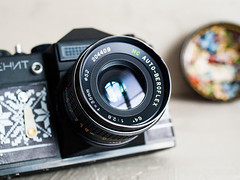
|
| Beroflex Auto MC 35/2.8 on customized Zenit ET image by Marian Pislaru (Image rights) |
- Beroflex Auto MC 35/2.8
Berogon
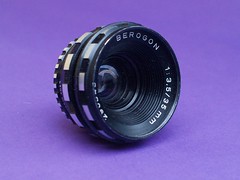
|
| Berogon 35mm 1:3.5 image by Uwe Kulick (Image rights) |
German brand, unknown German maker
Berthiot
- 150/5.5 Téléobjectif, chrome with one black ring (eBay auction)
- 200/4.5, chrome (eBay auction)
Beauty
This unusual and rare lens was one of the earliest Japanese zoom lenses built for still cameras. It was introduced at the 1962 Nippon Camera Show. The lens design includes 15 elements in 10 groups, and features an unusual direct lever zoom mechanism that is very different from conventional twist or push/pull zooms.[1]
- 50–100/3 Zoom-Biokor[2]
Cimko
- 35/2.8 Cimko compact, 52mm filter size.
Corfield
Corfield seems to have sold some lenses in 42mm screw mount for its M42 Periflex models. These lenses were made by Enna.
- 95/2.8 Lumar (manual)
- 135/3.5 Lumax (preset?)
- 400/4.5 Lumax (preset?)
Enna
Enna was a German independent optical company that made most of their lenses in M42 mount. Some were sold under the Revue distributor name. Here are the known types of finish:
- type I: chrome, preset or manual diaphragm
- type II: black with knurled rings and wide chrome stripes, preset diaphragm
- type II tele: black with wide chrome stripes, manual diaphragm
- type III: black with many fine chrome stripes, auto diaphragm
- type III tele: all black, crackled finish, except the base with chrome stripes, manual diaphragm
- type IV: all black, auto diaphragm
The lenses are listed, with the types known to exist for sure:
|
|
Enna also made a range of socket lenses. A socket base comprised the mount and focusing mechanism, and an interchangeable optical unit could be mounted on it. There were two generations of socket lenses, one with semi-automatic diaphragm (manual cocking) and the other with fully auto diaphragm. The two generations were mutually incompatible.
Lenses for the first socket system (black with wide chrome stripes):
- 28/3.5 Lithagon
- 35/2.8 Lithagon
- 50/1.9 Ennalyt
- 135/3.5 Tele-Ennalyt
- 240/4.5 Tele-Ennalyt
At the beginning, on the lenses sold on the US market, the name Lithagon and Ennalyt was replaced by Sandmar.
Lenses for the second socket system (black with many thin chrome stripes):
- 24/4 Ennalyt
- 28/3.5 Lithagon, later Ennalyt
- 35/2.8 Lithagon, later Ennalyt
- 50/1.9 Ennalyt
- 90/2.8 Tele-Ennalyt
- 135/2.8 Tele-Ennalyt
- 240/4.5 Tele-Ennalyt
FED
- Industar-10 (copy of the Leitz Elmar 50mm f3.5)
- Industar-61 1:2.8/50mm
- Kaleinar-5N
Feinmess
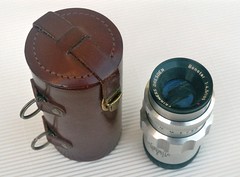
|
| image by Uwe Kulick (Image rights) |
The East German optical company Feinmess made one lens in M42 mount, the 105/4.5 Bonotar, in aluminium finish with knurled rings. This lens also equipped some East German 6×9 folding cameras like the Belfoca. It is said about 14000 were produced in M42 mount.
Fuji
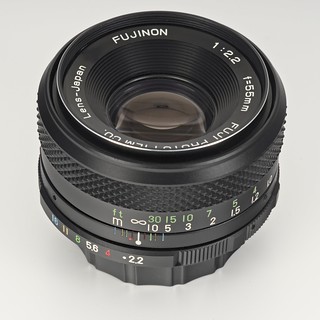
|
| Late version Fujinon f/2.2/55mm image by Jörg Krüger (Image rights) |
Fuji made many lenses in M42 mount, which they adopted for their SLR bodies in the 1970s.
Note that Fujinon lenses made from 1972 onwards were designed to work with the Fujica ST801 and later cameras, and provide open-aperture metering. This was facilitated by a small protruding tab on the edge of the aperture ring, which engaged with a nub on the camera lens mounting flange, and communicates the aperture setting to the camera's metering system. This can make the lenses incompatible with some other M42 cameras, since it prevents the lens from screwing fully on to the camera body, which results in loss of infinity focus. These lenses also have a locking mechanism, but this does not affect their use on other camera bodies as it is the body that has the protruding catch, and the lens just a small recess on its mating face.
While unmodified Fujinon lenses do fit many M42-mount camera bodies, some lens flanges (or lens adapters) are large enough in diameter that the tab interferes with mounting the lens. Aggravatingly, these lenses are sometimes found to have had their aperture coupling tab filed off (negating their open-aperture metering function). Provided the camera body (or adapter) mounting flange diameter is 54mm or less, Fujica lenses with an aperture indexing tab should fit.
Early Fujinon lenses (pre 1972 and designed for the stop-down metering Fujica ST701), do not have a "tab". They feature a full-metal, wave-shaped focus ring. The aperture ring is silver with black numbers on it (although there was a version of these lenses with black aperture dials). These lenses require stop-down metering.
Later open-aperture "tabbed" lenses have a rubberized focus ring, the aperture ring is black, and some f-stops are coloured, corresponding to the depth-of-field scale. These lenses all accommodate open aperture metering, but only when fitted to Fujica camera bodies with this capability. There were styling differences between export and home market lenses.
Late Fujinon lenses (the 55mm f/2.2 and f/1.6) introduced the use of plastic external controls and some of the internals.
The Fujinon lenses don't have an A/M-switch, so they can only stopped down by pressing the aperture pin inside the thread mount (apart from the long tele lenses with manual aperture). This has to be done by the camera and it is sometimes impossible when using an adapter. So, when Fuji changed from M42 to the X-bayonet mount, they offered an adapter for the new cameras which can close the aperture.
|
|
Fujita
Nine models, from 35mm to 400mm.[5]
Hanimar
Japanese manufacturer
- 35/2.8 auto
- 135/2.8 auto 'S'
Hoya
Hoya lenses are labelled Hoya HMC (also made in other mounts). The finish of the lenses is quite high, they are black with chrome aperture rings. Judging from a couple of samples, all are auto-only. Tha range includes 24mm to 400mm primes and a couple of zooms. They were possibly made by Tokina. Sources are scarce however.[6] Some collectors doubt that Tokina (or any other) made Hoya due to superior quality of the Hoya lenses to similar Tokina lenses.
Ichizuka
Ichizuka made at least one lens in M42 mount:
- Telinar 105mm f/4.5, aluminium, manual diaphragm
Isco
Isco was a successor of Schneider, and made a lesser range of lenses, some in M42 mount. Here are the known types of finish:
- type I: all chrome, slim barrel manual diaphragm
- type Iex: all chrome, external diaphragm release, probably for the early Praktica or Edixa
- type II: chrome, big knurled rings
- type IIex: idem, external diaphragm release
- type III: all black, big knurled rings
- type IV: shape of inverted cone, black with wide chrome stripes, auto diaphragm
- type V: shape of inverted cone, all black, auto diaphragm
The lenses are listed, with the types known to exist for sure:
- 24/4.0 Westrogon (IV)
- 28/4.0 Westron (III,V preset, ?/stops down to f22)
- 35/2.8 Westron (V)
- 35/3.5 Westron (IV, V)
- 50/1.9 Auto-Westagon (III)
- 50/1.9 Westrocolor (IIIex)
- 50/1.9 Westromat (IV, V)
- 50/2.0 Edixa-Westagon (II, IIex)
- 50/2.8 Westar (I)
- 50/2.8 ISCONAR (I)
- 50/2.8 Westanar (Iex, II, IIex)
- 50/2.8 ISCOLOR (IV)
- 50/2.8 Iscotar (IV, V)
- 80/2.8 Isconar (? preset)
- 85/2.8 Westanar (I)
- 85/4.0 Isconar (? preset)
- 90/1.9 Iscaron (? preset)
- 100/4.0 Isconar (III)
- 100/4.5 Westar (I)
- 135/2.8 Tele-Iscaron (III)
- 135/3.5 Tele-Westanar (III, IV, V)
- 135/4.0 Isconar (III, V)
- 150/4.5 Westanar (I)
- 180/2.8 Iscaron (?/auto)
- 180/2.8 Tele-Iscaron (III, V preset)
- 180/4.0 Tele-Westanar (III click stop)
- 180/4.5 Edixa-Westanar (I)
- 400/4.5 Tele-Westanar (III click stop)
JML
- JML Optical 28mm f2.8, made in Japan for JML
Kilfitt
Kilfitt lenses had a set of adapters, to attach them to various lens mounts. The only Kilfitt lens with a fixed 42mm screw mount was the 40mm Makro-Kilar. The Makro-Kilar D focused to 1:1 and the Makro-Kilar E to 1:2.
- 4cm f/3.5 Makro-Kilar D, chrome, s/n 211-XXXX
- 4cm f/3.5 Makro-Kilar E, chrome, s/n 209-XXXX
- 4cm f/2.8 Makro-Kilar D, chrome, then black, s/n 245-XXXX
- 4cm f/2.8 Makro-Kilar E, chrome, then black, s/n 246-XXXX
The markings evolved from Kamerabau-Anstalt-Vaduz Kilfitt-Makro-Kilar to Heinz Kilfitt München Makro-Kilar to Kilfitt München Makro-Kilar.
The lenses that were supplied with M42 adapters are:
- 75/1.3 Zoomatar (very rare)
- 90/2.5 Kilar
- 90/2.8 Macro-Kilar (macro range depends on focus-unit)
- 135/3.8 Kilar
- 150/3.5 Kilar
- 250/4.0 Reflectar
- 300/4.0 Fern-Kilar
- 300/5.6 Fern-Kilar
- 400/4.0 Sport-Zoomatar
- 400/4.0 Sport-Fern Kilar
- 600/5.6 Sport-Fern Kilar (two versions: older version focuses to 10m, newer version focuses to 4m)
- 50-125/4.5 Macro Zoomar (focusing to 1:1)
Kilfitt manufactured the world's first production zoom lens for 35mm still cameras. The lens was originally designed by Frank G. Back, and manufactured by Kilfitt for Voigtlander. Kilfitt produced a version in M42 mount with Voigtlander markings. In 1967/68 Frank G. Back acquired the Kilfitt company upon Mr. Kilfitt's retirement, and continued to sell Kilfitt lenses under the Zoomar brand name.
- 36-82/2.8 Voigtlander Zoomar
KMZ
KMZ (Krasnogorski mekhanicheski zavod/Krasnogorsk Mechanical Factory) made many Zenit SLRs since 1953. The first model with M42 is Zenit-E/Zenit-B sice 1965. KMZ is still producing M42 SLRs in the 21st century. (Some Zenit cameras were also made by BelOMO.) The majority of the standard lenses for Zenit were made by KMZ, but some were made by other factories.
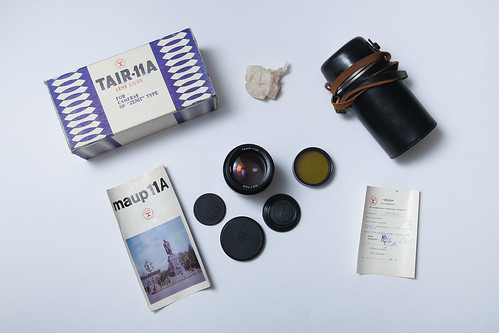
|
| Tair-11A image by PlanktonMSC (Image rights) |
- Helios-40 85mm F1.5
- Helios-44 58mm F2 (some were made by BelOMO)
- Helios–77 50mm F1.8 made by VOMZ
- Industar-50-2 50mmF3.5 (Industar-50 is M39 mount)
- Industar-61L/Z 50mmF2.8 made by LZOS
- Jupiter-6 180mm F2.8
- Jupiter-9 85mm F2 made by LZOS
- Jupiter-11 135mm f/3.5
- Jupiter-21 200mm F4.0 made by VOMZ
- Jupiter-37A 135mm F3.5 made by KOMZ
- Mir-1B 37mm F2.8 made by VOMZ
- MC Mir-20 20mm F3.5
- MC Mir-47 20mm F2.5 made by VOMZ
- MC Rubinar 300mm F4.5 made by LZOS
- MC Rubinar 500mm F8 macro made by LZOS
- Tair-3 300mm 1:4.5
- Tair-11A 135mm F2.8
- MC Telezenitar 135mm F2.8
- Volna-9 50mm F2.8 made by LZOS
- MC Zenitar 16mm F2.8 Fisheye
- Zenitar-M 50mm F1.7 (for Zenit-19)
- MC Zenitar-M 50mm F1.9
- MC Zenitar-M2S 50mm F2.0 (for Zenit-122)
Sankyō Kōki / Komura
These are marked Sankyo Kohki. Incomplete list:
- 85/1.4, in all black and all chrome version, preset
- 105/2, all black, preset
- 200/4.5, black with chrome andblack mount, manual or preset
Kowa
Kowa made a single lens in 42mm screw mount. See Kowa lenses for other cameras.
- Prominar 200mm f/2.8, black with wide chrome stripes, preset, 1958–9
Kyoei (Acall)
Twenty models, from 35mm to 500mm, with the Acall brand name.[7]
E.Ludwig
Ernst Ludwig was the maker of optical lens in Weixdorf, made triplet type lens Victar, Peronar, Meritar etc. Meritar lenses for the Exakta (or Exa) are numerous, but M42 type are not. There are some types of M42 mount.
- 50/2.9 Meritar (all silver finish, preset diaphragm to16)
- 50/2.9 Meritar (silver and black ring cone shape, preset diaphragm to16 )
Mamiya-Sekor
The first series was made for the Mamiya TL/DTL cameras, the second for MSX/DSX ones. The lenses were also sold under the Sears brand. These lenses have very good optics and a good construction.
First Series: Mamiya-Sekor
- 28mm f/2.8
- 35mm f/2.8
- 50mm f/2.0 (TL/DTL-I/DTL-II)
- 50mm f/2.8
- 55mm f/1.8
- 55mm f/1.4
- 60mm f/2.8 Macro
- 135mm f/2.8 (TL/DTL)
- 135mm f/3.5
- 200mm f/4.5
- 200mm f/3.5 (I/II/III)
- 400mm f/6.3

|
| Mamiya/Sekor SX image by Jörg Krüger (Image rights) |
Second Series: Mamiya-Sekor SX
- 14mm f/3.5 Fisheye
- 21mm f/4.0
- 28mm f/2.8
- 35mm f/2.8
- 50mm f/1.4
- 50mm f/2.0
- 55mm f/1.4
- 55mm f/1.8
- 60mm f/2.8 Macro
- 85mm f/1.7
- 85mm f/2.8
- 90-230mm f/4.5 Zoom
- 100mm f/2.8
- 105mm f/2.8
- 135mm f/2.8
- 200mm f/3.5
- 300mm f/5.6
- 600mm f/8.0
- 800mm f/8.0
Meyer
Meyer was the second East German provider of lenses in 42mm screw mount, after Carl Zeiss Jena. They mostly equipped the East German SLRs Contax S or Praktica.
The main types of finish are listed in chronological order:
- type 0: alu finish, slim barrel, manual diaphragm
- type I: alu finish, knurled focusing ring, preset or semi-auto (manual rewind) diaphragm
- type II: black with chrome stripes, auto or preset diaphragm
- type III: black, slightly knurled focusing ring, some chrome on diaphragm ring, auto diaphragm
- type Tele: alu or black finish, manual or preset diaphragm (tele lenses)
- type Tele II: black with spaced chrome stripes, knurled focusing ring, preset diaphragm
The lenses are listed, with the types known to exist for sure:
|
|
Miranda
A Japanese optical maker Miranda, whose former name was Orion Camera, made the first Japanese SLR with prism finder in 1955. Most SLRs had an original bayonet mount. They were also sold by the name of Soligor.
The lenses of the first period were made by other companies. They built the lens factory, and made the lens there since 1964. It went bankrupt in 1976. They made M42 camera MIRANDA-TM (SOLIGOR-TM), based on an existing model MIRANDA SENSOMAT RE in 1974.
- 50/1.8 AUTO MIRANDA TM (AUTO SOLIGOR TM)
Nittō Kōgaku
Nine lenses (some branded Kominar), from 28mm through 400mm.[8]
- 55/2.8 MEPRO KOMINAR (for MEPRO ZENIT, preset diaphragm)
Olympus
Olympus made a small range of lenses in M42 mount, for their FTL body. There is a rumor saying that these lenses were not designed nor built by Olympus, and that they had nothing to see with the later OM lenses. However their characteristics are very similar to the equivalent OM lenses.
- 28/3.5
- 35/2.8
- 50/1.4
- 50/1.8
- 135/3.5
- 200/4
These lenses have an additional pin to lock them into place on the FTL body. On some other M42 bodies, this pin could prevent mounting.
Pentacon
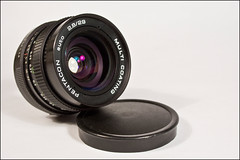
|
| Pentacon 29/2.8 auto (IV MC) image by bottledog (Image rights) |
"Pentacon" became the new brand and trademark name of most Meyer lenses after the lens maker was taken over by Pentacon in 1968. The Pentacon lenses have no individual name, just the Pentacon auto marking.
Finish types continue the Meyer types:
- type III: black, knurled focusing ring, diaphragm ring black or with some chrome
- type IV: all black with a diamond pattern on the focusing ring, later with multicoating
The lenses marked Pentacon auto had auto diaphragm, the lenses simply marked Pentacon had preset diaphragm. Some lenses had electric contacts, for the last Praktica bodies using the M42 mount, and were marked Pentacon electric.
The lenses are listed, with the types known to exist for sure:
- Pentacon 24/2.8 electric MC
- Pentacon 29/2.8 auto (IV MC)
- Pentacon 29/2.8 electric (IV MC)
- Pentacon 30/3.5
- Domiplan 2.8/50
- 50/1.8 auto (III, IV MC), some with Multi Coating marked in red letters
- 50/1.8 electric (IV MC)
- 135/2.8 (IV)
- 135/2.8 auto (III, IV MC)
- Pentacon 135/2.8 electric (III, IV MC)
- Pentacon 200/4 (IV)
- Pentacon 200/4 auto (IV MC)
- Pentacon 200/4 electric (IV MC)
- 300/4 (IV)
- 3.5/39-80 electric (MC, OEM by Sigma)
- 2x converter electric (IV)
The 50/1.8 exists in IV MC finish with Auto Revuenon markings.
Petri (Kuribayashi)
Petri, whose former name was Kuribayashi Camera, was a Japanese optical maker establised in 1907. The first SLR "Petri Penta" (1959) and some models of the last period (1976–83) have M42 mount. (Petri FT1000, Petri SD200, Petri MF-1, Petri MF-T 1000, Petri MF-101A, Hanimex CR1000, Hanimex SR2000, Petri MF-10, etc.) Some products were also made by other companies (Chinon, etc.) with the name Petri.
The Petri Orikkor M42 optional preset zebra-finish lenses for the Petri Penta (1959-1960) were mostly made by Kyoei. Most if not all these lenses can also be found under the Kyoei Acall brand, in black.
Kyoei lenses -
- 35/3.5 - 5 elements
- 105/3.5 - 3 elements
- 135/3.5 - 4 elements
- 180/3.5 - 4 elements
- 500/8 - 2 elements
- 50/2 C.C. Petri Orikkor (preset diaphragm) for the Petri Penta (1959) - unknown maker
Later 1970s M42 lenses (incomplete list)
- 50/1.8 auto
- 55/1.8 C.C. Auto Petri (automatic diaphragm)
- 85-205/3.5 C.C. Petri Auto Zoom (automatic diaphragm)
- 135/2.8 MC auto
- 200/3.5 Petri C.C. Auto
Piesker
Piesker made some lenses in M42 mount.
- 35/2.8 Voss
- 100/2.8 Voss
- 135/3.5 Picon
- 135/3.5 Votar
- 180/5.5 Tele-Votar
- 250/5.5 Tele-Votar
Porst
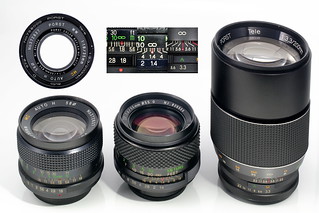
|
| Set of Porst lenses image by Jörg Krüger (Image rights) |
Porst was a German retailer, who sold cameras under different own brandnames. As M42 cameras some models of Cosina were sold, so you can find many Cosina lenses labeled with Porst. However, there are lenses of many different manufactures rebadged with Porst.
Rau Optik
Rau Optik made at least one lens under license from Astro Berlin, the Astro-Astan 4.7cm f/2.9. [9]
Revuenon
The German company Foto-Quelle sold cameras under its own brandname "Revue", and "Revueflex" for some SLR-cameras. The according lenses were branded "Revuenon". The OEMs of a large part of those cameras were Pentacon (Praktica) and Chinon, so you can find many lenses of those manufactures rebadged, e.g. the 1.8/50 auto Revuenon alias 1.8/50 Pentacon auto is widespread. Foto-Quelle offered lenses from further manufactures, e.g. Enna.
Known lenses:
- 24mm f/4 Macro Revuenon MC
- 35mm f/2.8 Revuenon-Special
- 50mm f/1.8 Revuenon (Pentacon auto)
- 50mm f/1.9 Revuenon (Chinon)
- 135mm f/2.8 Revuenon
- 135mm f/2.8 Revuenon-Special
Ricoh
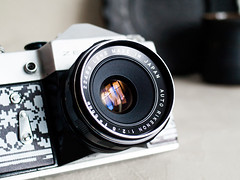
|
| Rikenon 55/2.8 on customized Zenit B/V image by Marian Pislaru (Image rights) |
- 50/1.7 Rikenon auto
- 55/1.4 Auto Rikenon
- 55/2.8 Auto Rikenon
Robotar
Japanese manufacturer
- 35/2.8 MC manual
Rodenstock
Rodenstock made some lenses in M42 mount, but they are quite uncommon.
- 30/2.8 Eurygon
- 35/4.0 Eurygon
- 50/1.9 Heligon, black with wide chrome stripes, knurled rings, semi-auto diaphragm with external release button for some Edixa models
- 50/2.0 Heligon
- 135/3.5 Yronar, chrome preset
- 180/4.5 Rotelar, black with wide chrome stripes, knurled rings, preset
Roeschlein
Roeschlein made at least one lens in M42 mount, the 13.5cm f/5.6 Telenar in chrome finish, with manual diaphragm (advertised as original at Leicashop).
Rollei
Some lenses were made in Singapore by Rollei under licence from Carl Zeiss, see also the Carl Zeiss Oberkochen section.
- Rollei 50mm f1.8 Planar (Made in Singapore by Rollei) (exists with and without HFT markings)
Schacht
Schacht also made some M42 lenses. Here are the known types of finish:
- type I: all chrome, massive knurled rings, manual diaphragm, some are marked Edixa-Reflex Germany on the barrel
- type II: black with wide chrome stripes, knurled rings, semi-auto diaphragm (needs manual winding)
- type III: black with wide chrome stripes, flat rings, auto diaphragm
The lenses are listed, with the types known to exist for sure:
- 35/2.8 Travegon-A
- 35/3.5 Travenar-R (III)
- 35/3.5 Travegon-R (III)
- 50/1.8 Travelon-A (III)
- 50/2.8 Travenar (I preset diaphragm)
- 50/2.8 Travenar-A (III)
- 50/2.8 Travenar-R (III)
- 90/2.8 Travenar-R (III)
- 100/3.3 Travegar
- 135/3.5 Travenar (I, II, III)
- 135/4.5 Travegon (I)
Schneider
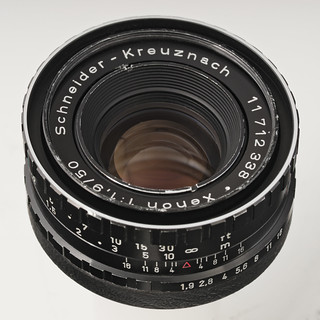
|
| Schneider-Kreuznach 1.9/50 Xenon image by Jörg Krüger (Image rights) |
Schneider made some of their lenses in M42 mount. The types of finish are listed in chronological order:
- type I: all chrome or black and chrome, manual or preset diaphragm
- type II: black with wide chrome stripes, knurled rings, preset or auto diaphragm, sometimes with Edixa markings
- type LM: like type II with the possibility to mount a selenium light meter above the lens
- type IIb: like type II with thinner chrome stripes and flatter rings, auto diaphragm, sometimes with Edixa markings
- type III: all black with a leatherette ring around the base, auto diaphragm
- type IIIb: like the III, with slightly conical focusing barrel
- type electric: black and leatherette with very thin chrome stripes, electric contacts for Praktica
The lenses are listed, with the types known to exist for sure:
- 28/4 Curtagon (II auto, LM, III, IIIb)
- 35/2.8 Curtagon (II auto, LM, III, IIIb)
- 35/4 PA-Curtagon: shift lens with its own special finish, manual diaphragm
- older version with focusing ring on the rear, behind the shift ring
- later version with focusing ring on the front
- 50/2.8 Xenar (I chrome, II, IIb)
- 50/2.8 Laudar(I preset)
- 50/1.9 Xenon (I chrome preset, II, LM, III, IIIb)
- 90/3.5 Xenar (I chrome)
- 135/3.5 Tele-Xenar (II auto, IIIb, electric)
- 200/5.5 Tele-Xenar (II preset)
- 300/5 Tele-Xenar (I chrome)
- 360/5.5 Tele-Xenar (II preset)
- 45-100/2.8 Variogon (IIb auto)
- 80-240/4 Tele-Variogon (IIb auto)
It is reported that the Rollei SL-Xenon 50/1.8 made for the Rolleiflex SL35 (see Rolleiflex SL35 lenses) existed in M42 mount too, maybe experimentally.
A weird 35/2.8 C-Curtagon lens with a very compact barrel appears regularly at eBay auctions; it is not sure whether it was designed for a camera model or for some other optical device. It has the same look as a quite recent enlarging lens, but it has a focusing ring, and a diaphragm ring with no preselection nor automation. Because of its strange aspect, it is sometimes advertised as a prototype at an inflated price, something it is obviously not. A rarer 28/4 C-Curtagon, probably from the same line, has no focusing ring nor diaphragm.
Siclass
Japanese manufacturer
- 28/2.8 auto
- 135/2.8 auto
Sigma
A very wide range of lenses; Miyazaki counts 148.[10]
- 28mm f/2.8 Miniwide
Soligor
Soligor made a range of lenses in M42 mount.
- 19-35 mm f3.5-4.5
- 28 mm f2.8 Wide-Auto
- 35 mm f2.8
- 28-105 mm f3.5-4.8
- 35-105mm f3.5
- 60-300 mm f4-5.6
- 70-210mm f/3.5 C/D Macro
- 90-230 mm f4.5
- 100 mm f2.8
- 100 mm f3.5 Macro
- 105 mm f2.8
- 135 mm f2 C/D
- 135 mm f2.8
- 135 mm f3.5
- 180 mm f3.5
- 200 mm f2.8
- 250 mm f4.5
- 500 mm f8 C/D Mirror
Steinheil
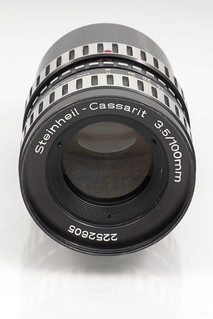
|
| Steinheil-Cassarit 3.5/100mm image by Jörg Krüger (Image rights) |
Steinheil made a range of lenses in M42 mount. The types of finish were:
- type 0: all chrome, slim barrel, manual diaphragm
- type I: all chrome, sometimes all black, knurled rings, preset diaphragm
- type preII: black with wide chrome stripes, knurled rings, auto diaphragm
- type II: black with wide chrome stripes, auto diaphragm, sometimes with Edixa markings
- type IIb: like type II with the stripes very close together
The lenses are listed, with the types known to exist for sure:
|
|
Sun
A large number of models marketed between 1961 and 1978.[11]
Tamron
A very wide range of lenses (Miyazaki counts 108 varieties), from 18mm through 500mm.[12]
Tokina
A very wide range of lenses, from 17mm through 800mm. These have the brands "Minetar" and "Lucky Tokina" as well as "Tokina".[13]
Tomioka
- 1:3.5 21mm Tominon
- 1:2 50mm Tominon C.
- 1:1.2 55mm Auto Tominon, mainly sold as Auto Yashinon Tomioka Japan, also marked Auto Revuenon Tomioka Japan or Auto Chinon Tomioka Japan, other markings w/o "Tomioka Japan" are uncertified as Tomioka products[14] Some say the 1:1.2 55mm Auto Tominon is the best m42 lens ever. For sure, it is one of the (still) most expensive lenses due to its great light.[15]
- 1:1.4 55mm Auto Tominon, also badged as Auto Chinon Tomioka Japan or Auto Revuenon Tomioka Japan
- 1:2.8 100mm Auto Tominon
- 1:2.8 135mm Auto Tominon
Vivitar
Vivitar is a highly regarded brand name, but in fact they were "just" rebranders. The company chose higher quality products to put their name on, but did not produce the optical equipment themselves. Vivitar sold an enormous range of M42-mount lenses, some of very poor quality and some of very good quality. Later lenses of higher quality are marked as part of their "Series 1" range.
Known lenses:
- 28mm f/2.5
- 35mm f/2.8
- 90mm f/3.5 Macro
- 100mm f/2.8
- 135mm f/2.8
- 135mm f/2.8 CF (close focussing)
- 200mm f/3.5
- 24-70mm f/3.8-4.8
- 28mm f/1.9
- 70-210mm f/3.5
- 105mm f/2.5 Macro 1:1
- 135mm f/2.3
- 450mm f/4.5 mirror lens
Weltblick

|
| Weltblick 3.5/35 & 3.5/135 image by Jörg Krüger (Image rights) |
Branding used by German retailer Neckermann to distribute lenses, typically of Japanese manufacture.
- 28mm f/2.8
- 35mm f/2.8
- 35mm f/3.5
- 55mm f/2.8
- 35-70/3.5-4.5
- 100-200 f/5.6
- 135mm f/1.8
- 135mm f/2.8
- 135mm f/3.5
- 300mm f/6.3 mirror
Yashica
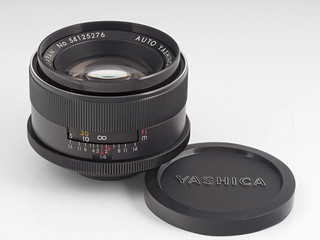
|
| Auto Yashinon DX 1.4/50 image by Jörg Krüger (Image rights) |
The Japanese camera maker Yashica made some SLRs with M42 auto diaphragm control mechanism: the Penta-J series from 1961 to 1968, and the TL and Electro series from 1967 to 1974. Yashica acquired Tomioka. It is said that many lenses are made by Tomioka, but some of the later period have similarity with Cosina or Chinon.
Here are the main types:
- type 1: semi-auto diaphragm control, marked AUTO YASHINON, for early period of J series
- type 2: preset diaphragm control, marked YASHINON, for early period of J series
- type 3: with auto/manual switch, marked AUTO YASHINON, for J and early period of TL series
- type 4: with auto/manual switch, marked AUTO YASHINON-DX, for TL series
- type 5: auto diaphragm control only, marked AUTO YASHINON-DS, for TL series
List of lenses:
- 50/2.0 Auto Yashinon (type 1,3)
- 50/2.8 Yashinon (type 2) Tessar type
- 50/1.9 Auto Yashinon-DS (type 4)
- 50/1.9 Auto Yashinon-DS (type 5)
- 50/1.7 Auto Yashinon-DX (type 3)
- 55/1.8 Auto Yashinon (type 3, marked 5.5cm)
Zeika
- Rojar 80mm f/3.5 (manual)
Zeiss
Carl Zeiss Jena
The first 42mm screw lenses were released for the Contax S, and made by Carl Zeiss Jena. The main types of finish are listed in chronological order:
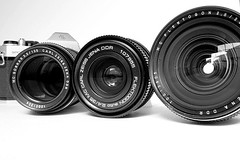
|
| Zeiss lenses from Jena image by Dennis Leonardo (Image rights) |
- type 0: black or alu finish, slim barrel, manual or preset diaphragm
- type I: alu finish, knurled focusing ring, manual, preset or semi-auto diaphragm
- type II: black with one chrome ring and leatherette on the focusing ring, auto diaphragm
- type III: black and chrome with a bumpy rubber focusing ring, auto diaphragm
- type IV: black with wide chrome stripes, auto diaphragm
- type V: all black with a diamond pattern on the focusing ring, auto diaphragm, later with MC multicoating
Some lenses of the type IV and V existed with electric contacts for the last Praktica bodies using the M42 mount.
The lenses are listed, with the types known to exist for sure:
|
|
|
A prototype Sonnar 1:2 f=57mm lens is known on prototype Contax S cameras, marked Zeiss-Ikon Dresden, not Carl Zeiss Jena.
A R-Biotar 75/1.5 (0) existed for X-ray photography.
Carl Zeiss Oberkochen
Made by the Western Carl Zeiss company.
Designed for the Icarex TM and SL706:
- 25/4 Distagon (few produced)
- 35/3.4 Skoparex
- 50/1.8 Ultron (concave front element)
- 50/2.8 Tessar
- 135/4 Dynarex

|
| Voigtländer Color-Skoparex 2.8/35 image by Jörg Krüger (Image rights) |
Designed for the VSL 1 (TM), and sold with Voigtländer or Rollei markings:
- 25/2.8 Color-Skoparex = 25/2.8 Distagon
- 35/2.8 Color-Skoparex
- 50/1.4 Nokton
- 50/1.8 Color-Ultron = 50/1.8 Planar
- 85/2.8 Color-Dynarex = 85/2.8 Sonnar
- 135/4 Color-Dynarex
- 200/4 Color-Dynarex
These two ranges of lenses are required to activate the open aperture exposure reading of the SL706 and VSL 1 (TM).
The 50/1.8 Color-Ultron existed under the name Ifbagon 50/1.8 to go with the Ifbaflex M102, a name variant of the VSL 1 (TM).
Notes
- ↑ http://www.asahi-net.or.jp/~hw6k-asi/old-lens/old-lens-biokor50-100.html
- ↑ Miyazaki, p.53.
- ↑ This lens is listed and depicted in the Fujica ST801 instruction manual, but may not have gone into production.
- ↑ This lens is listed and depicted in the Fujica ST801 instruction manual, but may not have gone into production.
- ↑ Miyazaki, p.53.
- ↑ Page at Photo.net
- ↑ Miyazaki, p.53.
- ↑ Miyazaki, pp.53–4.
- ↑ Seen only once at an ebay auction.
- ↑ Miyazaki, p.51.
- ↑ Miyazaki, p.52.
- ↑ Miyazaki, p.54.
- ↑ Miyazaki, p.54.
- ↑ Exclude the Tomioka impostor
- ↑ Tomioka 55mm f/1.2 lens formerly shown in Kensetsu's camera collection (archived). There are doubts that it's over-estimated and many more fast fields/woods/lanes standard lenses are ilegally sold as "tomioka-made", see Kameradoktor about Tomioka hype
- ↑ 20/2.8 Flektogon (V MC) at mflenses.com
- ↑ 35/2.4 Flektogon at vintage-camera-lenses.com
Links and sources
- Miyazaki Yōji (宮崎洋司). Yomigaeru ka, M42 maunto renzu no sekai o yuku: Kokusan kamera mēkā to M42 renzu (よみがえるか、M42マウントレンズの世界をゆく:国産カメラメーカーとM42レンズ). Shashin Kōgyō (写真工業), April 2003. Pp.47–56. This issue of the magazine also has other articles about M42.
- Database of M42 lenses at m42lens.com
- artlimited.net (archived), dedicated to M42
- Günther Kadlubek u. Rodulf Hillebrand: "Kadlubeks Objektiv Katalog", Neuss 2000 (1)
- Database of M42 lenses (archived) at PhotoPentax.com
- [Lens reviews] Lens reviews of most M42 Pentax lenses at [Pentax Forums ]
